SIX PAINTINGS BY CHARLES FREDERICK GOLDIE
1870–1947

4
Martin Creed
Work No. 2314
Christchurch Art Gallery Foundation Collection, commissioned 2015, gift of Neil Graham (Grumps)
Photo: John Collie
GRUMPY GRAHAM
At Grumpy’s funeral service a rendition of What a Wonderful World by Louis Armstrong was played. We were asked to remember good times — and we did. He was such fun and he lived life to the full and to its end.
Christchurch Art Gallery Te Puna o Waiwhetū was a grateful recipient of his generosity and largesse. And only a week before he died, he was the guest of honour at our 2015 Foundation dinner. These annual events, designed to ensure support for our collections during the Gallery’s five-year closure for earthquake strengthening following the Canterbury earthquakes of 2010–11. They were black-tie dinners, but while I visited him during a short spell in hospital prior to the event, he wondered if he could wear his jeans. How many others would have asked this, I still ask myself? And to whom else would I happily say it was all right?
For, Grumpy had donated the third great work for Christchurch, Martin Creed’s Everything is Going to be Alright. Against all odds at a time of repair, Gallery staff worked to ensure that it was ready in time; and it was lit up at that dinner on 23 September 2015. He received a huge standing ovation — and he deserved it! Of course he was pleased, but he was especially delighted when he heard that someone in Christchurch Hospital had seen it that evening and been buoyed by its message. And this says so much about him.
Prior to his gift, I and our Gallery fundraiser visited him at home quite a bit to talk about it. Champagne was always on ice, and sometimes we cooked for him. His own collection was varied and would not have had a Creed in it. But how well I recall his pride when he showed us his six Goldies in a room of their own. They were special to a special man and I think they will remain special…
So here’s a toast to Grumps (never Neil to us)!
Jenny Harper
Former Director
Christchurch Art Gallery Te Puna o Waiwhetū
5

6
Neil Graham ONZM was a larger-than-life character. He had an undeniable presence and everyone who met him seemingly has a tale to share. I first encountered him when conducting a fundraising auction for Christchurch Art Gallery Te Puna o Waiwhetū around ten years ago. Even in the context of a packed room and a fervent atmosphere, he was unmissable. Generously bidding lots, often without assistance, to five or ten times the then-increment, all for the benefit of the arts and his beloved hometown of Christchurch.
Neil was acutely aware that the arts had a key role to play in the rebuilding of the community spirit of Christchurch in the aftermath of the devastating earthquakes of 2010–2011, and he was more than prepared to support that role. His generosity extended beyond the arts to all manner of community and humanitarian causes including programmes for funding schools in Rwanda and supporting the police’s ‘Blue Light’ youth organization.
He came to art collecting relatively late in life, around the time he retired from the Mainfreight board, the company he joined in 1979, in 2011 due to ill health. During his time at Mainfreight he oversaw, along with business partner Bruce Plested, the growth of a fledgling trucking company into the largest freight forwarder in the country. Not bad for a boy who was expelled from two secondary schools.
Art collections come in all shapes and sizes. Seldom are they this significant or this focused, in both scope and quality. Neil collected simply the very best paintings by Charles Frederick Goldie available to the market. His collection amounts to six superb portrait paintings by this country’s most well-known artist. Each is impeccably provenanced and among the artist’s finest examples.
We’ve made an attempt with this catalogue and auction to observe tikanga Māori and to acknowledge that Goldie’s paintings of elderly Rangatira and wāhine Māori mean different things to Māori and Pākehā. We are particularly grateful to Rangihīroa Panoho and Ngahiraka Mason for joining our regular art writers in providing an invaluable Māori perspective.
Charles Goldie’s paintings have been celebrated and reviled in near equal measure by both Māori and Pākehā and there is little doubt his work will continue to incite and provoke intense debate. His portraits of Māori are the most widely-recognized images in New Zealand art history and will continue to occupy a unique position in our collective consciousness. The last major exhibition of Goldie’s paintings was in 1997 at the Auckland Art Gallery Toi o Tāmaki, and in being entrusted with this collection of paintings we made the decision that the right thing to do was to present them together, as a collection, so as everyone could have the opportunity to view and enjoy the undeniable technical virtuosity and historical significance of Charles Frederick Goldie’s paintings of Māori.
Ben Plumbly
7
Charles Frederick Goldie
The Whitening Snows of the Venerable Elder: Atama Paparangi oil on board signed and dated 1913 lower right; title inscribed on original painted plaque affixed verso 300 x 220mm: oval format
$600 000 – $900 000
Exhibited
John Leech Gallery, Auckland, 1913. John Leech Gallery, Auckland, 1957 (38 guineas). ‘GOLDIE’, Auckland Art Gallery Toi o Tāmaki, 28 June – 28 October 1997.
Provenance
Collection of C. K Mills. Purchased from John Leech Gallery, Auckland in 1957. Thence by descent. Purchased from Webb’s, Auckland 27 March 2013, Lot No. 24.
8
1

9
While Charles Frederick Goldie’s ‘photorealist’ portraits of Māori continue to be celebrated as records of rangatira ‘leaders’ they also possess complex cultural layers that enhance their value. Goldie and portraits like The Whitening Snows of the Venerable Elder: Atama Paparangi reveal a gifted artist who further honed his skills at the Académie Julian in Paris (1893–1898). However, these works also approximate the role taonga play in important Māori rituals like hui and tangihanga. The distinction, involving object and culturally treasured icon, requires careful unpackaging. The value Māori place on these ancestral portraits is surprising given Goldie’s belief they were a ‘dying race’. This trope, present in both his writing and his art, was perhaps a convenient and dramatic focus despite his having access (through his brother – a health professional) to census records proving the opposite. Goldie’s philosophy shares the recuperative approach present in ethnology and in the work of other colonial artists working in countries where indigenous peoples and cultures were under serious threat. Contemporary, Edward S. Curtis’s (1868–1952) 40,000 photographic portraits of Native American Indians, demonstrate a not dissimilar focus on this impending loss. Goldie is interested in loss but more its theatre. How does such loss feel? What role might gesture, symbol and titles play in conveying it?
Contriving cultural contexts, dressing up elderly native subjects and employing nostalgia, are responses to these challenges both artists share. Goldie dresses Paparangi in shared cultural props: korowai and hei tiki found in portraits of many other Māori sitters. Curtis puts Native Americans in their most spectacular ceremonial wear and edits out modernity. Wigs hide modern haircuts. Backdrops and other pictorial devices disguise contemporary context. In The Whitening
Snows… Paparangi’s glance is downcast. The artist dampens tone and darkens colour to highlight the white and silver strands of Atama’s hair, and by implication, the age of the sitter and the impending demise of culture. In other works background fires smoulder symbolically. Curtis, similarly, was fond of sunsets.
So what was the Māori response, to these manipulations, to their image as dour metaphor and commodity (i.e. Goldie’s decision to paint in smaller A4 sized oil on wood – 1913 onwards) and to the artist’s abiding Social Darwinism? Silence. Instead sitters like Ngāti Tūwharetoa ariki Te Heuheu Tūkino VI observed these images ‘becoming’, tohu mō ngā Māori i roto i te whakatupuranga ‘‘‘icons’’ or symbols for future generations.’ Paparangi, who returned to Goldie’s studio at least once, spoke lovingly not of his own representation (a photographic copy the artist sent of a large 1914 portrait) but rather his people’s affection for the image. He nui te mīharo o tōku iwi ki wāu mahinga pai. ‘My people have a great admiration for your good work.’
Goldie’s portraits then, for Te Heuheu and Paparangi, involve what late twentieth century English anthropologist Alfred Gell was to describe as agency. They are not simply aesthetic objects rather meaning and value derives from their ability to affect or to move their communities emotionally and spiritually.
Rangihīroa Panoho
10
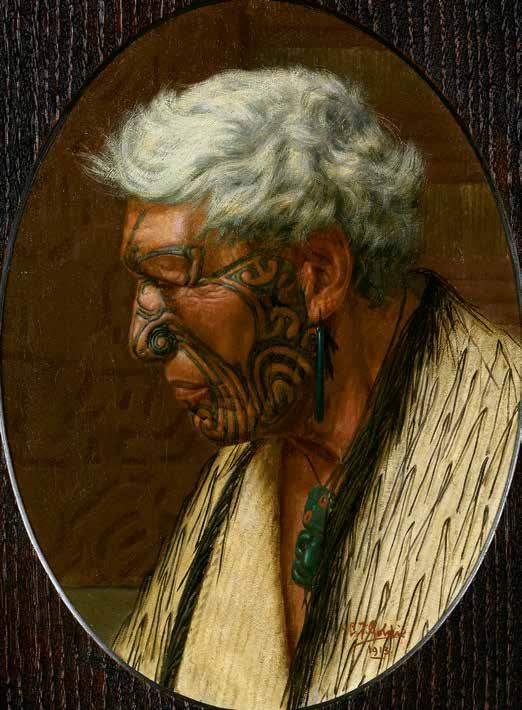
11
Charles Frederick Goldie
‘Day Dreams’, Nataria Rangimangeo Mitchell (nee Haupapa) – Te Arawa Tribe oil on canvas signed and dated 1938 in brushpoint upper left 310 x 256mm
$450 000 – $650 000
Provenance
Collection of the Buckland family Auckland and housed at Higwic House, Newmarket, Auckland. Thence by descent to Graham Roy.
Private collection, Auckland.
Purchased from Webb’s, Auckland 27 March 2013, Lot No. 36.
12 2
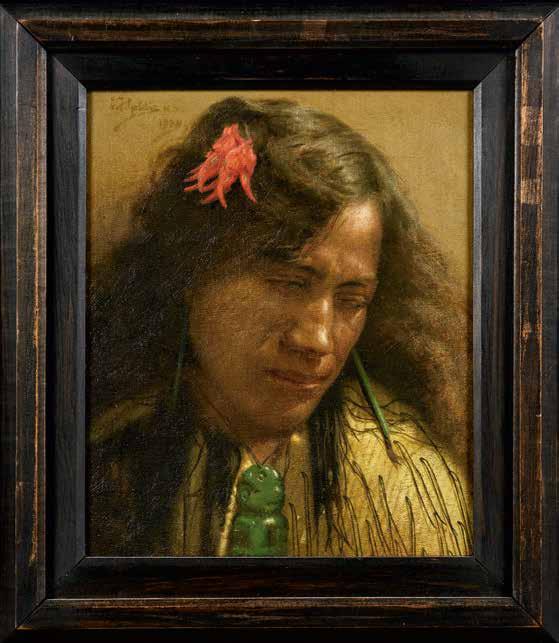
13
Nataria Mitchell was a notable figure of the renowned Haupapa whānau through her father, Rotohiko Tangonui Haupapa. Her mother, Te Ririu Meretini Pango, was part of the celebrated Pango family recognized for their expertise in the history and whakapapa of Te Arawa. Nataria married James Niramona Zealand Mitchell, who was a surveyor belonging to the Ngāti Te Takinga, Ngāti Pikiao people, and with Scottish ancestry. Together, they raised five children. On both sides of her whakapapa, Nataria traced her genealogy back to the ancestors who voyaged on the Te Arawa canoe from Hawaiki to Aotearoa on one of the seven waka from the last great migration. Nataria lived from July 1887 to December 1962, and she passed away at the age of 75 years in Ohinemutu, as documented in Te Ao Hou – No. 42 (March 1963) and is buried at Ngōngotaha’s Kauae cemetery.
Charles. F Goldie was an academic painter who frequently visited Te Papaiouru village in Rotorua to arrange portraiture sessions with Te Arawa people from the turn of the twentieth century. He obtained permission from the villagers to capture their likenesses; sometimes, he would paint a person more than once. This modest-sized portrait of Nataria Mitchell is signed and dated 1938.
The painting shows a ngūtu kāka (clianthus puniceus) cluster of blooms conspicuously arranged on Nataria’s hair. The focal points of the painting are the red flowers, a kuru pounamu ear ornament, and a heitiki pendant. Nataria’s pose symbolizes how Goldie depicted Māori ancestors in the 19th Century Victorian Romanticist portraiture aesthetic of ‘reverie’ — dreamlike and lost in time, a style he embraced. Goldie also used ‘reverie’ in portrait titles of notable ancestors, such as Reverie – Pipi Haerehuka – Chieftainess of the Arawa Tribe.
In 1932, Goldie painted an earlier introspective portrait of Nataria Mitchell titled Reverie (Hinemoa, Te Arawa). It is signed, dated, and similar in size to the one available at this auction . In the earlier 1932 portrait, the color values Goldie chose to highlight her facial details produced a sense of mystery or foreboding. The painting shows the kaka-beak flower with the shrub’s greenery attached, and the kuru pounamu earring is omitted from the picture. Beyond that, we know it is Nataria.
Continuous histories keep connections active, and a painted portrait can immediately recall the past. In 2008, Netahio Theo Tait from the chiefly Ohinemutu Tait whānau, read in the Herald newspaper that a picture of Hariata Huirua, a Tuhourangi chiefess, painted in 1921 by C.F Goldie, was sold at auction after being in a one-family collection for 87 years until the 2008 auction. Netahio expressed wanting to meet the new owner of the portrait to share what he remembered about his paternal grandmother.
Hariata Huirua and Nataria Mitchell knew each other’s families through generations of kinship ties, and Te Arawa iwi, hapu, and whānau have perpetual hereditary relations. Like their forebears, the Mitchell, Haupapa, and Tait families still live in the Te Papaiouru village, and their intergenerational stories include portraits of historical significance painted by Goldie.
Ngahiraka Mason Oahu, Hawai‘i
14

15
Charles Frederick Goldie
Te Aho-o-te-Rangi Wharepu, A Noted Waikato
Warrior oil on canvas signed and dated 1913 in brushpoint; inscribed Te Aho o te Rangi Wharepu on brass panel mounted to centre recto of frame; remnants of artist’s original catalogue label affixed verso
760 x 642mm
$2 000 000 – $3 000 000
Reference
Alister Taylor and Jan Glen, C.F Goldie: His Life and Painting (Martinborough, 1977), p. 228.
Literature
New Zealand Herald, September 27, 1963. George Walker (auction catalogue), May 21, 1976. The Evening Post, May 22, 1976.
New Zealand Herald, May 22, 1976.
Otago Daily Times, May 22, 1976. Better Business, September 1976, p. 35.
Provenance
Private collection, Auckland. Purchased September 26, 1963.
Private collection, Auckland. Purchased George Walker Auctions, May 21, 1976.
Private collection, Auckland. Purchased International Art Centre, Auckland, April 1977. Purchased by Neil Graham privately, circa 2012.
16 3

17
In 1913 Goldie was New Zealand’s most popular artist, while his subject, Te Aho-o-teRangi Wharepu (c.1811–1910) was one of the best known Māori rangatira. He was also one of the artist’s most favoured models, featuring in at least ten paintings, most notably for his celebrated All ‘e Same te Pakeha: (1905, Dunedin Public Art Gallery), subtitled A Good Joke in its coloured lithographic versions (1910 and 1916). Over his working life Goldie (1870–1947) made a practice of repeating earlier paintings, and indeed there are almost identical portraits of Te Aho with similar titles in the Auckland Museum (1901, gifted by Goldie’s widow in 1951) and in the Russell Cotes Museum (1907), Bournemouth (UK). The first portrait was exhibited at the Auckland Society of Arts in 1902 and 1905. There’s a photograph of the latter show, in which it and All ‘e Same t’e Pakeha are strikingly prominent in the crowded hang with their wide dark wooden frames, designed by Goldie and inspired by seventeenth century Dutch ones, such as those used by Rembrandt (much admired by Goldie). As with this 1913 portrait of Te Aho, these frames served to concentrate the focus on the person and accentuate their miniaturist precision and extraordinary illusionism, so that it can seem as if we, the viewers, are looking through a window at an actual person – proto‘virtual reality’.
Te Aho is right in the picture’s front plane, looking directly back at us, his gaze intent and piercing. In most of Goldie’s paintings of elderly Māori, the figure looks down or away, as if submitting to the viewer, the object of their gaze. In this portrait, though, it is a faceto-face encounter, almost, but for the frame, as if we share the same space. Te Aho’s presence is palpable (or as much as that is possible with a painting). Clad in traditional costume, his moko, facial features, ear pendants and hei
tiki rendered sharply, the brushwork of his face imperceptible, he is set in shallow space against a more loosely painted ground, which serves to further emphasise his face, moko and gaze. The image, thus, has the force of an icon, a figure who commands the space he occupies. As such, this was apt presentation of Te Aho, who appears to have had special significance for Goldie, whose signature is inscribed just to the right of Te Aho’s face, as if they constituted a kind of partnership.
Te Aho (Ngāti Mahuta) lived at Waiariki Pa near Mercer, south of Auckland. He participated in the Waikato Land Wars, notably at Rangiriri (1863). He was an expert on waka construction, had a central role in its revival, and was recognised as such in the early twentieth century. Te Aho is reputed to have done some tattooing of Māori women at the turn of the century (Waiariki Pa was the centre of a female tattooing revival among Tainui iwi then), at a time when this activity, like waka construction, was an assertion of distinct cultural identity. Te Aho was a man of great mana, noted for his strength and resilience, evident in this portrait. Ngāti Mahuta were most active in the King Movement, with Tāwhaio, the second Māori king, and Mahuta, the third, both Ngāti Mahuta. They were all activists in resistance to loss of land to Pakeha expansionism and in the protection of traditional practices and Māori identity.
In 1913 visiting British artist, Stephen Haweis (1878–1969) described Goldie’s Māori subject paintings as the most representative of New Zealand of any art he’d seen here. Had he seen this portrait of Te Aho? Certainly it is one of Goldie’s best.
Leonard Bell
18
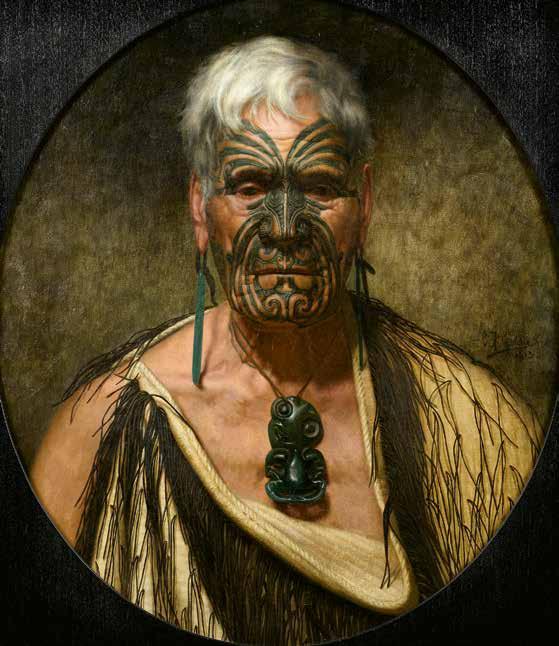
19
Charles Frederick Goldie
‘A Midsummer’s Day’, Maoriland: Pōkai – A Warrior Chieftain of the Ngāti Maru Tribe oil on canvas on board signed and dated 1937 in brushpoint upper right; title inscribed and inscribed Cat No. I on artist’s original catalogue label affixed verso; original Royal Academy exhibition (1943) labels affixed verso; original Société des artistes francais blindstamp applied verso; inscribed on original receipt addressed to Speight and dated 15/7/47: Pokai purchased – feel sure you will approve, regards Charles affixed verso 400 x 452mm
$850 000 – $1 350 000
Exhibited
Salon of the Société des artistes francais, Paris, 1938.
‘C. F Goldie’, John Leech Galleries, Auckland, 1948.
Reference
Alister Taylor and Jan Glen, C.F Goldie: His Life and Painting (Martinborough, 1977), p. 277.
Literature: The Evening Post, November 30, 1937. New Zealand Herald, May 9, 1939.
C. F Goldie, Scrapbooks (Auckland Museum).
C.F Goldie, Scrapbooks (National Art Gallery).
Provenance
Collection of Hugh Speight, of the Speight’s Brewery family, Dunedin. Purchased on 15 July 1947 for £345. Thence by descent.
Purchased from Dunbar Sloane, Wellington, November 30 2011, Lot No. 40.
20 4

21
After winning prizes for his work at the Auckland Society of Arts, Charles Goldie was inspired by the example of his teacher Louis John Steele to travel to France to perfect his technique. In July 1893, the 22-year-old Goldie enrolled at the Académie Julian in Paris, a private art school set up by Rodolphe Julian in Paris in 1868. Unlike the École des Beaux-Arts where Steele had studied, Julian admitted women and foreigners, and did not require proficiency in French. The instructors there were academic artists, upholding the standards of the French Académie des Beaux-Arts.
Goldie was to spend four-and-a-half years steeping himself in traditional academic approaches to figure painting at the Académie Julian, winning a gold medal for life painting in 1896. As well as visiting art museums to draw from the Old Masters, he travelled to Scotland for a six-month period in 1897 to study more modern techniques with the famed Scottish portraitist and “Glasgow Boy”, James Guthrie (1859-1930). Guthrie, who became president of the Royal Scottish Academy and was knighted in 1903 for his services to portraiture, painted with broad, square brushstrokes and was very influenced by the French Realists as well as Velázquez and Whistler. Goldie learned to refine his approach to rendering the texture and tone of skin, hair and clothing and combine this with naturalistic light effects that made it seem as if sunlight was falling on the face of his sitters.
Returning to Auckland in mid-1898, Goldie was recognised as one of the most highly skilled and well-trained artists of his generation. He set up his studio on the top floor of Hobson’s Buildings, then next door to the Auckland Star office in Shortland Street, and recruited many Māori to sit for him, paying them a daily stipend and accommodation allowance.
As they sat in front of him, he made pencil sketches, and took photographs from different angles to use for reference as he worked up his oil painting later. This sitter, Hori Pōkai who was Ngāti Maru from Pūkorokoro (Miranda) and died in 1920, was posed draped in a korowai with two-stranded tassels or hukahuka, which Goldie owned.
Pōkai was the subject of at least ten portraits by Goldie, the earliest of which dates to 1905 when the artist visited Thames. The lines of Pōkai’s facial tattoo were deeply incised, made by tapping a bone chisel lashed to a small wooden haft to carve the pattern into the skin before a pigment made from a mixture of soot, oil and water was applied. By the time Goldie made his subsequent portraits of Hori Pōkai in 1917 and 1919, this way of chiselling tā moko into the skin was increasingly rare. Here, Pōkai’s head is turned to the side, so that the focus is not on the determined jaw that is a feature of the 1919 portrait A Sturdy, Stubborn Chief and 1921’s Pōkai the Strategist, but on the incised lines on Pōkai’s cheek and chin.
On exhibition, Goldie’s works always stood out in their distinctive black timber frames, but during the Depression years of the 1930s, opportunities to show and sell work in New Zealand decreased, and the work of more modern artists such as Rita Angus came to the fore. The English Governor-General, Lord Bledisloe, encouraged Goldie to send his work to the Royal Academy in London, which accepted three works in 1934 and a fourth in 1935, but rejected all the works sent after that date, including this one. Annoyed by the English Academicians disdain, Goldie turned back to Paris, and was delighted to have his first painting accepted at the French Salon in 1935, followed by a further two in 1936. This portrait of Hori Pōkai was one of the two works which he had sent off in a blaze of
22
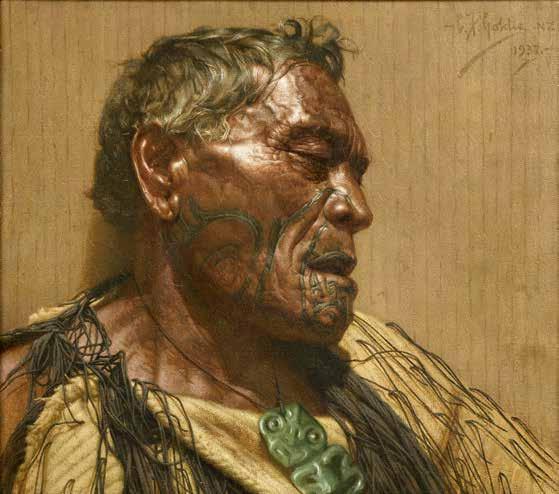
newspaper publicity to the Royal Academy in 1937 only to be rejected summarily. He dispatched the same works the following year to Paris where they were accepted by the Salon, with In Dreamland even illustrated in the 1938 Salon catalogue. Now in his late sixties, Goldie’s career had come full circle, with artistic success in Paris, the city which had nurtured his talent 45 years before.
Linda Tyler
23
Charles Frederick Goldie
Kamariera Te Hau Takiri Wharepapa oil on canvas, 1910 accompanied by copy of original letter and receipt signed by the artist and dated March 2nd 1910 460 x 405mm
$1 000 000 – $1 600 000
Provenance
Purchased directly from the artist by Mr Alex Crawford. Thence by descent. Purchased from Page Blackie Galleries, Wellington, 2010.
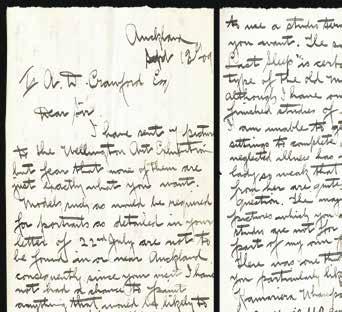


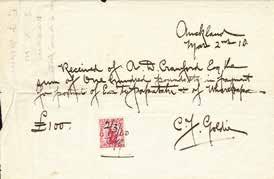
24 5

25
From a distance, the face is closed, hieratic, and a bit intimidating. Up close, the eyes seem unreadable, withdrawn, perhaps dazed. They stare without focussing. They (deliberately?) do not meet our gaze. Each individual strand of the subject’s silver hair is carefully teased up in a contemporary cut; the myriad wrinkles on his forehead echo the horizontal lines on our right; the chisel marks of his tā moko are so lifelike that he appears to float ethereally off the canvas towards us. The dark brown frame appears perfect for the variously spiced browns of the composition: the subject’s skin, the horizontal cross-hatch on our right, the slightly darker carved background on our left. These browns are all carefully keyed to the dark green of the large tiki on the subject’s chest and the almost glowing tā moko dye. The modelling of the face seems to carve forward into shallow space while the background presses back. Formally, there is a mighty push and pull. The sitter is both ardent and shy; morbid and sublimely exalted in equal measure. It is these features that make the painting at once modern in spirit but conservative in its forms.
Charles Frederick Goldie was a secondgeneration New Zealander who went to Auckland College and Grammar School. At the age of 23 he left to study in Paris at the Acadèmie Julian, the only New Zealand painter of his generation to undertake the full rigours of French academic training. It was an academic tradition that privileged the intensity of realism derived in part from the reaction of French artists to the invention of photography. Indeed, in 1911 a critic aptly described Goldie’s style as ‘photo-realist’, commenting that ‘his artistic ideal seems to be the coloured photograph’. Back in New Zealand he expressed his desire to set up a school along the lines of his French teaching institution and did so with mentor and fellow
painter Louis John Steele. They opened in Shortland Street and named it, somewhat pretentiously, ‘The French Academy of Art’. In the first five years of the twentieth century Goldie chose to concentrate on depicting elderly Māori with tā moko. He described them as the ‘noble relics of a noble race’. In doing so he put his subjects not only on view but on trial. He was not alone in this view of Māori doomed to extinction, Walter Buller, the famous ornithologist, declared he wanted to ‘smooth down their dying pillow’. How does Wharepapa measure up? Is he a tragic figure or a fearless one? Is his stony, unrelenting gaze a rejection of Goldie’s pessimistic view? A counter to the hegemony of colonial oppression?
Immaculately rendered on canvases which he prepared with a textured ground, the paintings were presented in distinctive purpose-crafted kauri frames. What surprises when you see a Goldie, in the flesh so to speak, is his subtle use of colour but also of contrasting textures. It is as if his figures were brought into being by cumulative soft strokes, a caress here and there. Occasional build-ups of strokes in certain passages — here it is Wharepapa’s hair and his lips marked by a subtle intrusion of his tā moko — advertise a protracted struggle to get the details right. Goldie’s models usually sat for him in his Auckland studio, draped in a cloak supplied by the artist, often with accompanying props. There are several photographs of Wharepapa in Goldie’s studio. Goldie’s popular fame may have been secure, but the critics grew increasingly tired of his minutely realistic portraits. By 1911, the year after Kamariera Te Hau Takiri Wharepapa was completed, Goldie’s style seemed dated and out of touch. He was criticised for being too realistic, too photographic and uninventive compared with the looser, more impressionistic style that was popular and now
26

27
being taught in art schools. Goldie rebutted the criticism arguing that Impressionism and Cubism were mere ‘cloaks for incompetency’. But in the 1920s, he barely produced anything and was plagued by ill health from alcoholism and lead poisoning from the white lead paint he used — apparently he used to lick the end of his brush to achieve a finer tip (hence the exquisite rendering of Wharepapa’s hair already noted). After his death in 1947, over the rest of the century, Goldie was increasingly dismissed by art critics, like the Herald ’s T.J McNamara, who became bored with what they considered his unadventurous style and limited subject range.
Kamariera Te Hau Takiri Wharepapa (1823–1919, the dates are disputed) was born at Mangākahia. In 1863 he was one of 14 Ngā Puhi Māori who travelled to England aboard the ship Ida Ziegler under the sponsorship of Wesleyan missionary William Jenkins. While in England he was presented to Queen Victoria and married Elizabeth Reid, an English housemaid. The first of their five daughters was born on the return journey to New Zealand and the family settled in Maungakahia in 1864 where Elizabeth helped her husband lobby for a school, which was eventually built. Wharepapa’s marriage to Elizabeth Reid was published in the English Mail with the headline ‘Amalgamation of the Races’ but it was not to last. There are four known portraits of Wharepapa by Goldie, two in private collections (of which this is one) and two in the Auckland Museum, one of which carries the title A Noble Relic of a Noble Race.
Layers of paint alternate with layers of glaze, giving Goldie’s best works a luminous glowing quality to the surface. When this is combined with intense attention to detail through the folds of the skin, the lines of the moko and the texture of the fabrics, the result is close
to a colour photograph. The brilliance and transparency of old-masterish multiple glaze techniques and the composed orderliness appears natural. But the orderliness of Goldie’s paintings is imposed, not organic. His portraits have an air of demonstration about them. Goldie’s correspondence with the first purchaser of Kamariera Te Hau Takiri Wharepapa speaks of the lighting being ‘in the manner of Rembrandt’. He also notes that he has deliberately changed his sitter’s pose from ‘a displeasing contra movement’ to ‘a full face view’. Most arresting of all is Goldie’s gift as a dramatist of personality. He may have dealt almost exclusively with Māori sitters—apparently he learnt enough te reo to communicate with his subjects—but he had the sense to know what made up a ‘type’, and it was not simply a physiognomy. While real life ‘figures’ the people in his paintings, they exist as fictional beings cobbled together in a collaboration between artist and, perhaps the unaware, sitter. The people in his portraits have the deep humour that good character actors bring to their roles; a quality of mysterious life beneath a surface. They could have ended up as caricatures but they aren’t. Each of them is capable of surprising us.
Goldie’s greatness is of a type that hides in plain sight. He is a far more subtle artist than might have been suspected by his countless admirers. Goldie is in the details. However, the quality for which he is almost universally praised — ‘minutely observed realism’ and ‘factual recording’ — is too nebulous. Something like ‘capturing personality with scintillant precision’ is more like it. Intimate with both subject and viewer, he dissolves emotional distances. Today Goldie still clamours for a proper role, seeking affirmation a century later. The more alert we are to the politics of the here and now, the more contemporary Goldie feels. He draws us on. For most part
28
the drama surrounds, and has followed, Goldie’s work rather than suffusing it. ‘What is a Goldie?’ we might ask. The answer could be a painting touched with both genius and a strange, thorny colonial politics. The effect is stirring and confusing. I find Goldie’s work hard to like and almost impossible not to admire. It constitutes a superb performance of painting within a questionable political context. Do his portraits promote a fixed and narrow perception of Māori as the ‘noble relics of a noble race’? Some critics have condemned his work as perpetuating a ‘comforting fiction’ from a patronising and now outdated European perspective. Curator Jim Barr even brashly dismissed it as ‘coon humour’. Or are Goldies taonga that provide a ‘living’ link to tupuna of the past? Te Heuheu Tukino, the paramount chief of Ngati Tuwharetoa and the artist’s friend, described Goldie’s works as ‘he tohu mo nga Māori i roto i te whakatupuranga’ — ‘icons for Māori of future generations’. Or, again, are some wealthy (Pākehā) buyers simply banking a Goldie ‘deposit’? Goldie, unsurprisingly, had deliberately targeted his sales at wealthy Americans and Europeans. Each time his viewer is forced to comb out tangled thoughts about this very conundrum. ‘Who is Goldie’s viewer?’ strikes me as the really compelling question. Sixty-six thousand museum-goers came to see the Goldie Māori portraits at the 1997 Auckland Art Gallery retrospective — thirty percent of them Māori (at the time the average Māori visitor rate to the gallery was about three and a half percent). There exists a shifting contingency that affects every one of his portraits, and makes it seem less certain whom he is addressing and why. This, of course, is part of their enduring power.
Laurence Simmons
29
Charles Frederick Goldie
‘Memories’: Hera Puna (Widow of the Noted Chief Hori Ngakapa)
oil on canvas signed and dated 1920; title inscribed and signed on artist’s original catalogue label affixed verso 255 x 206mm
$600 000 – $900 000
Provenance
Purchased from Fisher Galleries, Auckland, circa 2008.
30 6

31
My cohort tended to think of Goldie as a documentarian rather than an expressive painter. If we ascribed any emotional resonance to his work, it was usually of the sentimental kind — the worn-out tropes of nostalgia, feigned regret, confected loss, the fading grandeur of a past that will not come again. While these were values which many members of his contemporary audience may have endorsed, they were no longer fashionable with us; indeed, they were more likely to inspire derision than admiration. We thought of him as of antiquarian interest only. So it comes as something of a shock to see his 1920 portrait of Hera Puna from the Neil Graham Collection: its genuine power as a miniature, its gravity, its emotional heft and its unmistakable truth to its subject.
Hera Puna, of Ngāti Whanaunga and Ngāti Pāoa, was born near Whitianga, probably in the 1830s, lived into her nineties, and died in the 1920s; her grave is at Waihihi, on the western side of the Firth of Thames with a view out over the sea to the Coromandel Ranges. She was renowned ‘as a singer of many waiata’. Her husband, Hori Ngakapa, was also of Ngāti Whanaunga. He was one of several rangatira who paddled their waka taua, fully loaded with armed warriors, to Auckland in 1851 to protest the treatment by Pakeha of a Hauraki rangatira Hoera. They landed at Mechanics Bay, gave the Aucklanders a severe fright, then left without engaging in hostilities.
Hera Puna fought alongside her husband during the wars in the Waikato in the 1860s. She was famous for saving his life during a skirmish at Drury. Hori Ngakapa had discharged both barrels of his tupara and needed time to reload; Hera stood in front of him and thereby prevented one of the soldiers from shooting him. The soldier’s fate is unrecorded. They also fought together at the
battles at Rangiriri and Ōrākau, where they were among those who survived by fleeing through the swamp at the back of the pa. Subsequently, in 1865, Hori Ngakapa, with others from Hauraki, and some from Ngāti Porou, endorsed a conditional peace with Pākehā at a hui in Thames. He was painted by Gottfried Lindauer in 1878 — the portrait is in the Auckland Art Gallery — and was several times photographed in the studio of Foy Brothers in Thames.
His wife, Hera Puna, was painted by Goldie on at least four occasions; they are all small works. This portrait, from 1920, is one of two made that year — also the year in which Goldie decamped to Sydney and there married his Australian wife, Olive Cooper, a milliner who ran a successful business on Karangahape Road. The best known of the four is the first, the 1917 version, Memories of a Heroine , which was stolen in Auckland in the year 2000, bought from the thieves for $10,000 by a businessman who wanted to remain anonymous, and returned to its owner, the Auckland Museum, gratis. I sometimes wonder if that businessman was the now disgraced James Wallace. The fourth version, dated 1933, is less known: Goldie, grandiloquently, claimed (in the title) that it showed the sitter as Rembrandt would have painted her.
Both the 1917 and the 1933 images show Hera Puna in left profile; while the other 1920 work, and also the only photo I have seen of her, show her from her right side. The 1917 work, in which she wears a green scarf and looks down, as so many of Goldie’s women do, is characterized by a rather studied melancholy. The 1933 image errs in the other direction, towards the histrionic, and recalls Goldie’s alcoholism and the hectic behaviour occasioned by his progressive lead poisoning
32
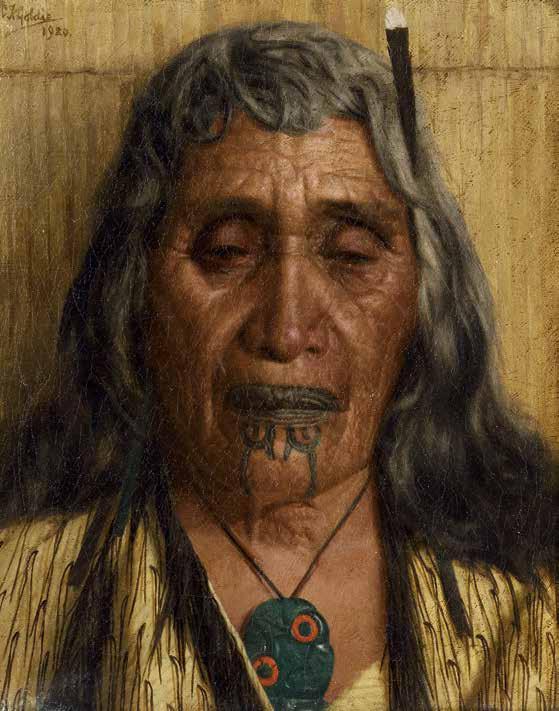
33
(caused in part by his habit of licking his brush in order to make a finer tip) in the last three decades of his life. The other work from 1920 is uncharacteristically bright (for a Goldie), highly detailed, and an excellent painting in its own right.
Goldie, during the three years he spent in Sydney, did a number of paintings from drawings made previously. However the accusation that he worked from photographs is probably false. Hera Puna must have sat for him. Either she came to Auckland and visited him in his studio or he went to Thames and drew her there. Whichever it was, it is most likely that they met in 1917; and that all subsequent works are based upon the drawings he made then. I like to think he went to her. Goldie was fluent in te reo and comfortable on the marae. He wasn’t a scholar and didn’t command the esoterica but conversational Māori was something he could do. He was, I think, smart enough to know that in his painting he was attempting to capture the wairua of the sitter: after all, what else does portraiture do?
Of the four, this is the only one in which Hera Puna is seen from the front, in extra close up as it were, a head and shoulders shot with just her heitiki, her korowai and a single huia feather visible. It is the gaze of the sitter, occluded though it is, that focusses your attention. It is both inward looking and receptive. She seems fixed in reverie while at the same time you sense her awareness of the painter and therefore of any viewer of the painting. It gives you an eerie sense of being present during an act of remembering, and somehow privileged to be included in that act. What she is remembering cannot of course be known but that isn’t the point of the painting; it is our presence before and with her that matters.
It’s worth noting that in the photograph referred to above, Hera Puna wears the same look that Goldie captures in the painting. It was published in James Cowan’s 1930 book The Māori: Yesterday and Today and appears in chapter eight, ‘The Poetry of the Māori’, along with the description of Hera as ‘the singer of many tangi-chants’. She is wearing the same korowai as in the Goldie painting and the photograph may have been taken when she sat for him. The relationship between portrait painting and photography is of course a contentious one and Goldie was accused, as early as 1911, of making paintings from photographs, as Lindauer undoubtedly did. The accusation seems quaint, indeed irrelevant now; while the existence of portraits like this one, alongside the photograph Cowan reproduces, suggests that in both mediums it is possible to capture the wairua of a subject in such a way that they may be strangely present before us, ‘in spirit’, a hundred years later; as Hera Puna undoubtedly is here.
Martin Edmond
34
35
CONDITIONS OF SALE
Please note: it is assumed that all bidders at auction have read and agreed to the conditions described on this page. Art+Object directors are available during the auction viewing to clarify any questions you may have.
1. REGISTRATION: Only registered bidders may bid at auction. You are required to complete a bidding card or absentee bidding form prior to the auction giving your correct name, address and telephone contact and supplementary information such as email addresses that you may wish to supply to Art+Object.
2. BIDDING: The highest bidder will be the purchaser subject to the auctioneer accepting the winning bid and any vendor’s reserve having been reached. The auctioneer has the right to refuse any bid. If this takes place or in the event of a dispute the auctioneer may call for bids at the previous lowest bid and proceed from this point. Bids advance at sums decreed by the auctioneer unless signaled otherwise by the auctioneer. No bids may be retracted. The auctioneer retains the right to bid on behalf of the vendor up to the reserve figure.
3. RESERVE: Lots are offered and sold subject to the vendor’s reserve price being met.
4. LOTS OFFERED AND SOLD AS DESCRIBED AND VIEWED:
Art+Object makes all attempts to accurately describe and catalogue lots offered for sale. Notwithstanding this neither the vendor nor Art+Object accepts any liability for errors of description or faults and imperfections whether described in writing or verbally. This applies to questions of authenticity and quality of the item. Buyers are deemed to have inspected the item thoroughly and proceed on their own judgment. The act of bidding is agreed by the buyer to be an indication that they are satisfied on all counts regarding condition and authenticity.
5. BUYERS PREMIUM: The purchaser by bidding acknowledges their acceptance of a buyers premium of 19% + GST to be added to the hammer price in the event of a successful sale at auction.
6. ART+OBJECT IS AN AGENT FOR A VENDOR: A+O has the right to conduct the sale of an item on behalf of a vendor. This may include withdrawing an item from sale for any reason.
7. PAYMENT: Successful bidders are required to make full payment immediately post sale – being either the day of the sale or the following day. If for any reason payment is delayed then a 20% deposit is required immediately and the balance to 100% required within 3 working days of the sale date. We accept payment via Eftpos, cash (under $5000.00) and direct credit. Visa and MasterCard credit cards are accepted, however a surcharge of 2.5% will be added. Payments over $10 000.00 must be made by direct credit to our bank account. Our bank details for deposits are 12-3107-0062934-00. Please use your buyer number as transaction reference. Please refer to point 7 of the Conditions of Sale in the catalogue for a detailed description of payment terms.
8. FAILURE TO MAKE PAYMENT: If a purchaser fails to make payment as outlined in point 7 above Art+Object may without any advice to the purchaser exercise its right to: a) rescind or stop the sale, b) re offer the lot for sale to an underbidder or at auction. Art+Object reserves the right to pursue the purchaser for any difference in sale proceeds if this course of action is chosen, c) to pursue legal remedy for breach of contract.
9. COLLECTION OF GOODS: Purchased items are to be removed from Art+Object premises immediately after payment or clearance of cheques. Absentee bidders must make provision for the uplifting of purchased items (see instructions on the facing page).
10. BIDDERS OBLIGATIONS: The act of bidding means all bidders acknowledge that they are personally responsible for payment if they are the successful bidder. This includes all registered absentee or telephone bidders. Bidders acting as an agent for a third party must obtain written authority from Art+Object and provide written instructions from any represented party and their express commitment to pay all funds relating to a successful bid by their nominated agent.
11. BIDS UNDER RESERVE & HIGHEST SUBJECT BIDS: When the highest bid is below the vendor’s reserve this work may be announced by the auctioneer as sold ‘subject to vendor’s authority’ or some similar phrase. The effect of this announcement is to signify that the highest bidder will be the purchaser at the bid price if the vendor accepts this price. If this highest bid is accepted then the purchaser has entered a contract to purchase the item at the bid price plus any relevant buyers premium.
IMPORTANT ADVICE FOR BUYERS
The following information does not form part of the conditions of sale, however buyers, particularly first time bidders are recommended to read these notes.
A. BIDDING AT AUCTION: Please ensure your instructions to the auctioneer are clear and easily understood. It is well to understand that during a busy sale with multiple bidders the auctioneer may not be able to see all bids at all times. It is recommended that you raise your bidding number clearly and without hesitation. If your bid is made in error or you have misunderstood the bidding level please advise the auctioneer immediately of your error – prior to the hammer falling. Please note that if you have made a bid and the hammer has fallen and you are the highest bidder you have entered a binding contract to purchase an item at the bid price. New bidders in particular are advised to make themselves known to the sale auctioneer who will assist you with any questions about the conduct of the auction.
B. ABSENTEE BIDDING: Art+Object welcomes absentee bids once the necessary authority has been completed and lodged with Art+Object. A+O will do all it can to ensure bids are lodged on your behalf but accepts no liability for failure to carry out these bids. See the Absentee bidding form in this catalogue for information on lodging absentee bids. These are accepted up to 2 hours prior to the published auction commencement.
C. TELEPHONE BIDS: The same conditions apply to telephone bids. It is highly preferable to bid over a landline as the vagaries of cellphone connections may result in disappointment. You will be telephoned prior to your indicated lot arising in the catalogue order. If the phone is engaged or connection impossible the sale will proceed without your bidding. At times during an auction the bidding can be frenetic so you need to be sure you give clear instructions to the person executing your bids. The auctioneer will endeavour to cater to the requirements of phone bidders but cannot wait for a phone bid so your prompt participation is requested.
D. NEW ZEALAND DOLLARS: All estimates in this catalogue are in New Zealand dollars. The amount to be paid by successful bidders on the payment date is the New Zealand dollar amount stated on the purchaser invoice. Exchange rate variations are at the risk of the purchaser.
36
ABSENTEE & PHONE BID FORM
Auction No. 194
Six Paintings by Charles Frederick Goldie (1870–1947) from The Collection of Neil Graham onzm (1943–2015) Auction: Monday 25 March 2024 at 6.30pm
Th is completed and signed form authorises Art+Object to bid on my behalf at the above mentioned auction for the following lots up to prices indicated below. These bids are to be executed at the lowest price levels possible.
I understand that if successful I will purchase the lot or lots at or below the prices listed on this form and the listed buyer s premium for this sale (19%) and GST on the buyers premium. I warrant also that I have read and understood and agree to comply with the condition s of sale as printed in the catalogue.
Bid maximum in New Zealand dollars (for absentee bids only)
Lot no.
Lot Description
Payment and Delivery: Art+Object will advise me as soon as is practical that I am the successful bidder of the lot or lots desc ribed above.
I agree to pay immediately on receipt of this advice. Payment will be by Eft pos, cash (under $5000.00) or direct credit. I understand that there is a 2.5% surcharge for payment by Visa or MasterCard credit cards. I understand that payments over $10,000.00 must be ma de by direct credit to Art+Object’s bank account as shown on the invoice.
I will arrange for collection or dispatch of my purchases. If Art+Object is instructed by me to arrange for packing and dispatc h of goods I agree to pay any costs incurred by Art+Object. Note: Art+Object requests that these shipping arrangements are made prior to the auction date to ensure prompt delivery processing.
Please indicate as appropriate by ticking the box:
FIRST NAME:
ADDRESS:
HOME PHONE:
BUS. PHONE:
PHONE BID
SURNAME:
MOBILE:
EMAIL:
ABSENTEE BID
Signed as agreed:
To register for Absentee or Phone Bidding this form must be lodged with Art+Object by 12pm on the day of the sale in one of three ways:
1. Email a printed, signed and scanned form to Art+Object: info@artandobject.co.nz
2. Fax a completed form to Art+Object: +64 9 354 4645
3. Post a form to Art+Object: PO Box 68345 Victoria Street West, Auckland 1142, New Zealand
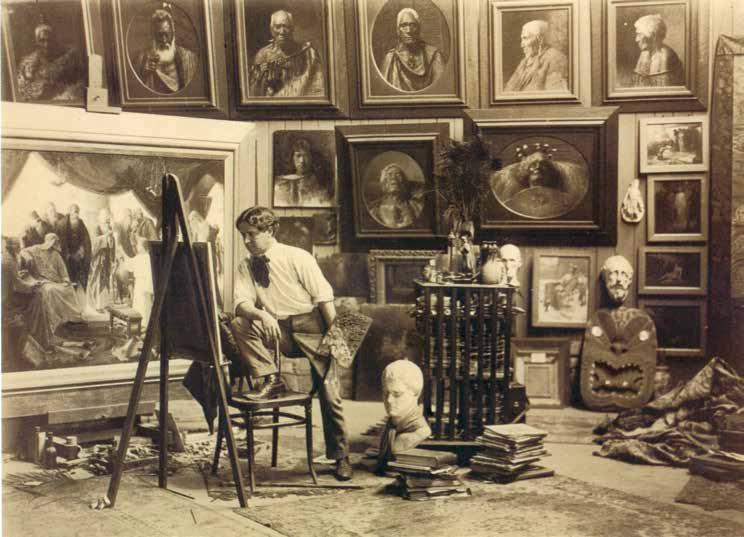
38 ART + OBJECT. 3 Abbey Street, Newton, Auckland 1010. PO Box 68345, Wellesley Street, Auckland 1141 Tel +64 9 354 4646, free 0800 806 001, fax +64 9 354 4645, info@artandobject.co.nz, artandobject.co.nz Instagram: @artandobject, Facebook: Art+Object, Youtube: ArtandObject
 Auckland Museum in March 1952, showing some of the twenty paintings donated by Olive Goldie in 1951. The carved panels are the work of Anaha Te Rāhui, whose portrait by Goldie is fourth from the right (photograph courtesy of NZ Herald Archive).
Auckland Museum in March 1952, showing some of the twenty paintings donated by Olive Goldie in 1951. The carved panels are the work of Anaha Te Rāhui, whose portrait by Goldie is fourth from the right (photograph courtesy of NZ Herald Archive).


















